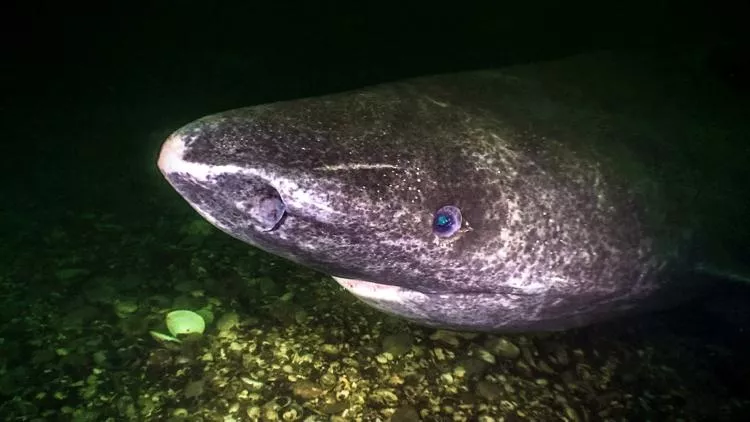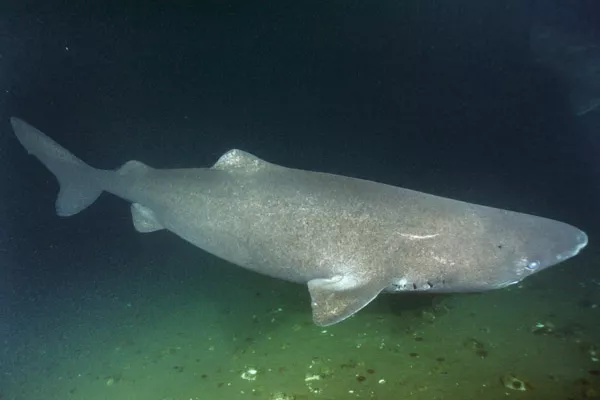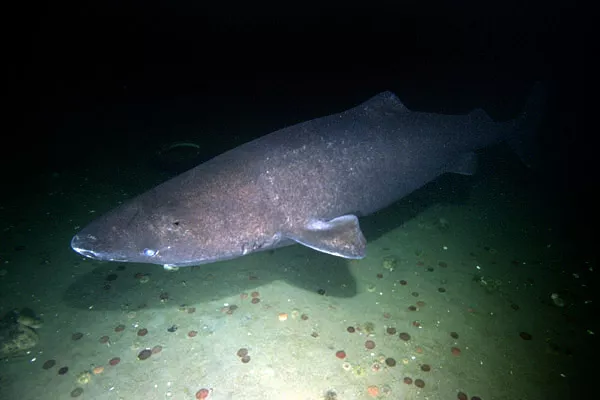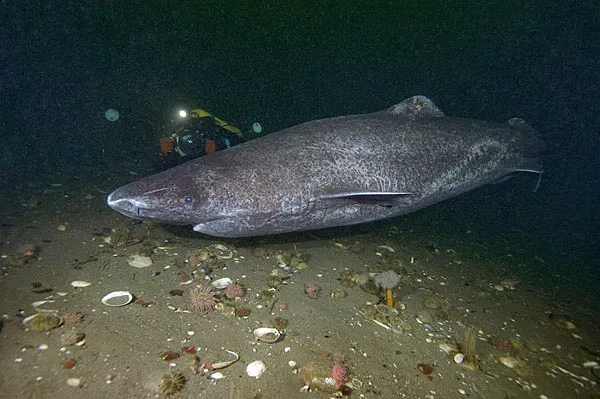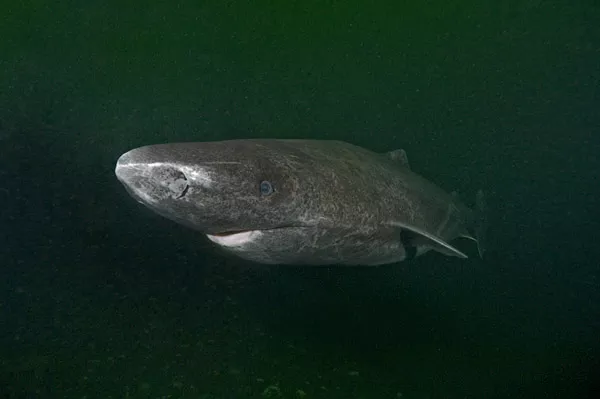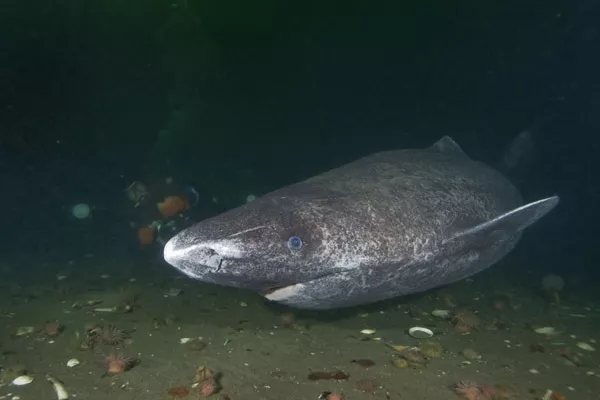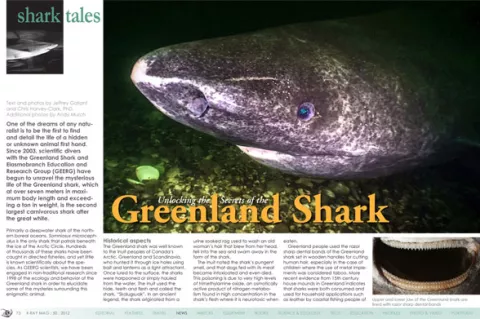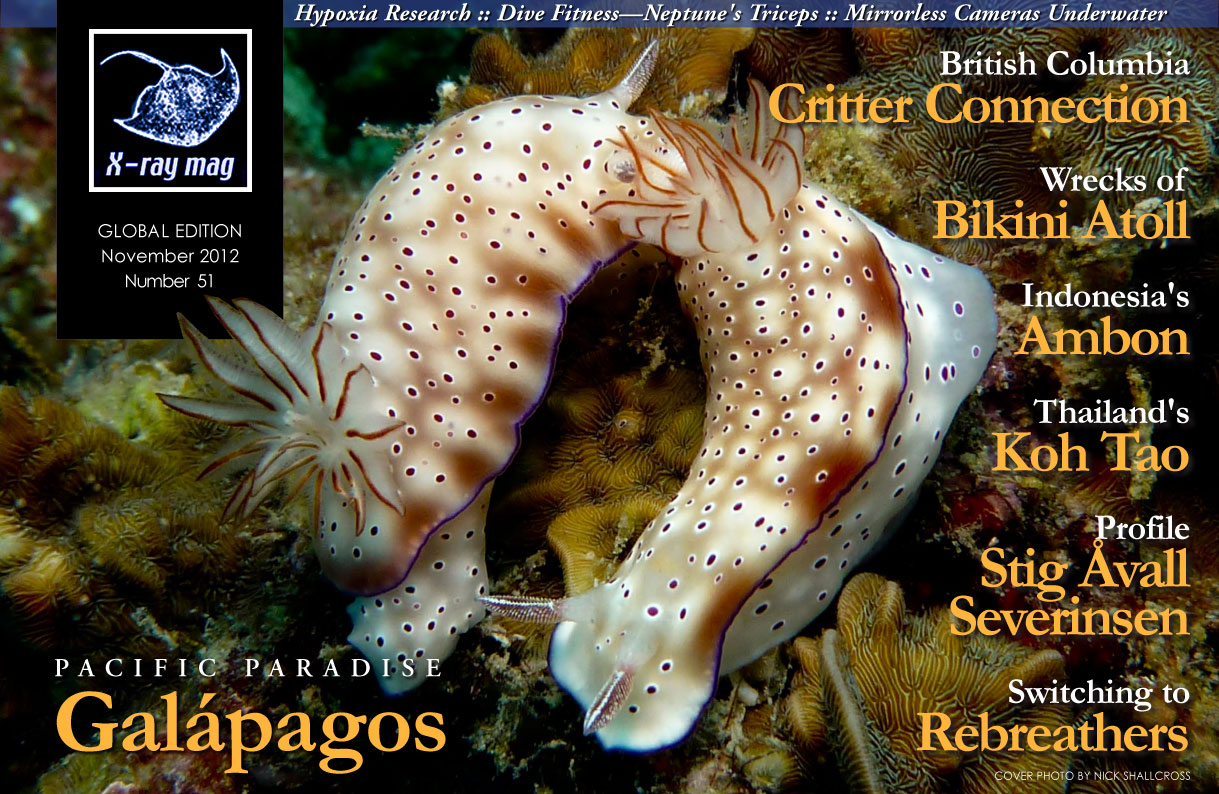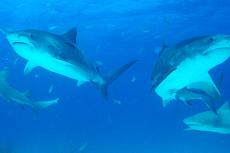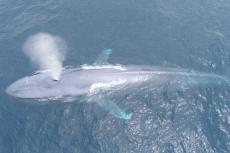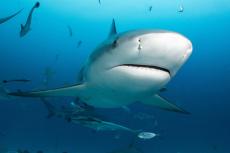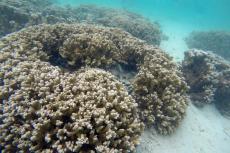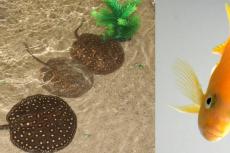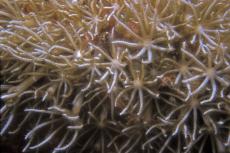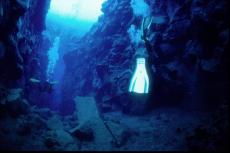One of the dreams of any naturalist is to be the first to find and detail the life of a hidden or unknown animal first hand. Since 2003, scientific divers with the Greenland Shark and Elasmobranch Education and Research Group (GEERG) have begun to unravel the mysterious life of the Greenland shark, which at over seven meters in maximum body length and exceeding a ton in weight, is the second largest carnivorous shark after the great white.
Contributed by
Factfile
Selected Reading:
Gallant, J., Harvey-Clark, C., Myers, R. A. and M. J. W. Stokesbury. 2005. Sea lamprey (Petromyzon marinus) feeding on a Greenland shark (Somniosus microcephalus) in the St. Lawrence Estuary, Canada. Northeastern Naturalist.
Stokesbury M.J.W, Harvey-Clark, C.J., Gallant, J., Block, B.A. and R. A. Myers. 2005. Movement and environmental preferences of Greenland sharks (Somniosus microcephalus) electronically tagged in the St. Lawrence Estuary, Canada. Marine Biology 148: 1159-165.
Harvey-Clark, C.J., Gallant, J.J., and Batt, J.H. 2005. Vision and its relationship to novel behaviour in St. Lawrence River Greenland sharks (Somniosus microcephalus) (Bloch and Schneider 1801) Canadian Field Naturalist 119: 355-358.
Primarily a deepwater shark of the northern boreal oceans, Somniosus microcephalus is the only shark that patrols beneath the ice of the Arctic Circle. Hundreds of thousands of these sharks have been caught in directed fisheries, and yet little is known scientifically about the species. As GEERG scientists, we have been engaged in non-traditional research since 1998 of the ecology and behavior of the Greenland shark in order to elucidate some of the mysteries surrounding this enigmatic animal.
Historical aspects
The Greenland shark was well known to the Inuit peoples of Canada’s Arctic, Greenland and Scandinavia, who hunted it through ice holes using bait and lanterns as a light attractant. Once lured to the surface, the sharks were harpooned or simply hauled from the water. The Inuit used the hide, teeth and flesh and called the shark, “Skalugsuak”. In an ancient legend, the shark originated from a urine soaked rag used to wash an old woman’s hair that blew from her head, fell into the sea and swam away in the form of the shark.
The Inuit noted the shark’s pungent smell, and that dogs fed with its meat became intoxicated and even died. This poisoning is due to very high levels of trimethylamine oxide, an osmotically active product of nitrogen metabolism found in high concentration in the shark’s flesh where it is neurotoxic when eaten.
Greenland people used the razor sharp dental bands of the Greenland shark set in wooden handles for cutting human hair, especially in the case of children where the use of metal implements was considered taboo. More recent evidence from 15th century house mounds in Greenland indicates that sharks were both consumed and used for household applications such as leather by coastal fishing people of Nordic origin.
In more modern times, peoples of Iceland and Greenland learned to ferment shark meat to destroy the toxin, and this “shark cheese”, known as Hákarl, is a pungent and prized delicacy in Iceland where it is washed down with an equally powerful locally made liquor called Brennivin.
Commercial fisheries for Greenland sharks have existed since the late 19th century, and Arctic whalers from Scotland noted the presence of hundreds of these voracious sharks around freshly killed whale carcasses during flensing and trying out operations. One of the earliest scientific drawings of a Greenland shark was made to illustrate whaler Captain William Scammons 19th century treatise on marine mammals, showing the shark with its characteristic spiracle and a copepod parasite attached to the eye.
By the late 19th century, an artisanal fishery for Greenland sharks had developed in coastal communities in northern Scandinavia, Greenland and Iceland, primarily for their livers. The huge organ (up to 150 kg) was placed in a container and would naturally ferment and separate into an oil-rich layer that could be extracted and used as a fuel for lamps, or could be rapidly rendered using heat to make a more pure form of combustible oil.
Modern times
The North Atlantic fishery for Greenland sharks peaked in the early 20th century when up to 32,000 tons per year were harvested. The fishery failed as fossil fuels became the chief source of inexpensive light and heat. In the latter part of the 20th century, Inuit people on Baffin Island developed ice fisheries for Greenland halibut, and found that Greenland sharks consumed their catch if gear was left in the water for too long. Scientist Aaron Fisk estimated several hundred sharks a year were killed as bycatch in this fishery.
Longline vessels in the winter fishery for Atlantic halibut off the coast of Nova Scotia have reported occasional catches of large Greenland sharks as bycatch, as have bottom trawl fisheries in the Gulf of St. Lawrence. Beck and Mansfield reported in the 1960s on Greenland shark depredation of Inuit net-based fisheries for narwhal, with spectacular photos of the lesion created by shark bites on the whales.
Biological aspects
The natural history of the Greenland shark is not well understood. A handful of publications exist in the scientific literature, and these have mostly focused on geographic distribution, diet and stomach contents, as well as the eye parasite that infects these animals.
The Greenland shark is large, heavy-bodied and has a reduced first dorsal fin, small second dorsal, smaller D-shaped pectoral fins, and a large, paddle-like heterocercal tail equipped with a water splitting caudal peduncle. The ground colour of the shark can vary from grey to mottled grey and white to dark brown or black; it's lighter on the underside. The skin is extremely rough, with large visible dermal denticles that easily cause lacerations when handling the animal.
The eyes are large with a pucker at the caudal corner and a prominent reflective tapetum that glows green in dark conditions when a light is shone on it. The head has large nares terminally, and the upper and lower surfaces of the head are liberally covered with electrosensory ampullae. The mouth is underslung and hard to visualize unless the observer is at the same level or underneath the animal. It is relatively small compared to the large size of the shark. When closed, the lower dental band is not visible.
When open during ram ventilation or feeding, the band everts and becomes visible and directed in a forward orientation. The upper teeth are not usually visible. The lower dental band consists of rows of small flat teeth oriented in a stacked narrow blade, which forms a knife edge, while the upper teeth are small, narrow and pointed, and primarily serve a gripping role during prehension.
When the shark bites, it everts the lower jaw, thrusting its head into the prey and locking the jaws in place with the upper teeth. It then rocks its entire body in a back-and-forth corkscrew motion while closing the jaws through the prey and scooping out a neat, concave ice-cream scoop lesion that may weight several kilograms. Sleeper shark bites to elephant seals in the Antarctic have been identified based on the characteristic smooth contour and lack of lacerations or punctures seen with other shark species (vanDenHoff and Morrice, 2008).
The Greenland shark has a large, muscular pharynx communicating with the gills, esophagus and small dorsal spiracles above and behind or medial to the eye. Spiracles may be useful when the animal is feeding or when gills are close to the bottom, as they permit water entry or exit from the pharynx through the top of the head. The five gill slits are sited ahead of and ventral to the pectoral fins. Intact, unmarked bottom dwelling fish are frequently found in the stomach of Greenland sharks and it is possible that this species may engage in suction feeding of buried or benthic fish while cruising over the bottom, which they detect using well developed electro-sensory capabilities.
The shark’s lateral line is dorsally oriented, which may reflect the ability to detect prey in the water column laterally and above the animal, which has a bottom dwelling habit at least part of the time. The pelvic fin is prominent, and in males, the claspers can extend another 10cm. Males have been observed minus a clasper, as well as with puffy and edematous claspers, perhaps the result of nuptial activity at the GEERG study site in northern Quebe, Canada.
The age of the Greenland shark cannot be established using the standard means for other shark species, as their notochord lacks the ring-like annulations seen in other sharks, and an early tagging paper suggested the growth rate of large adults might be only 0.5-1cm per year, meaning adult sharks could be centuries old.
Males can be sexually mature at 2.5 meters total length, while limited dissections of stranded females have shown even animals at 3.5 metres total length do not yet have mature ovaries. Year-to-year observations underwater using laser measurement of animals by GEERG indicate there is little length change over a period of three years in at least one animal. GEERG has also established that Greenland sharks in the St. Lawrence Estuary exhibit filopatry, with at least one animal found within 100m of the same site over two consecutive years.
Deep sea predator and scavenger
The Greenland shark is among the deepest dwelling sharks and has been found to depths in excess of 2,200 metres, where it is thought to be an important whale carcass and deepsea squid scavenger. In the Arctic, it has been observed in shallow water at the sites of beluga and narwhal kills, literally almost beaching itself to get to carcasses.
This species has a varied diet and stomachs—up to 20 percent of total body mass—have been found containing a wide range of prey species consisting of benthic and pelagic fish and mammals, as well as garbage of human origin, domestic animal carcasses and a range of invertebrate species representing all major marine phyla. A key mystery has been whether these seemingly slow-moving sharks can capture fast-swimming fish such as salmon, and agile large brained prey such as seals, or whether this is the result of scavenging dead carcasses.
Although there is no conclusive proof, GEERG scientists are fairly convinced that the Greenland shark does occasionally predate live seals. However, the victim would probably be an inexperienced or sleeping pup, or be distracted, injured, in an ice hole or in poor visibility offering the seal no warning of the incoming shark’s presence. The Greenland shark is more likely to feed on an already dead seal, which requires no energy output and offers no risk of injury, for even small seals have sizeable teeth with which to defend themselves.
Agility and stealth
The Greenland shark is nonetheless capable of swift movement. GEERG divers have observed this underwater on numerous occasions while attaching tags to sharks with a spear-like device. Sharks were also observed bolting when touched or approached too closely by divers. They can no doubt swoop on prey, although it would probably amount to no more than a few quick bursts.
The Greenland shark is also capable of stealth. We experienced this firsthand when a four-metre shark surprised us in low visibility right under the boat and at a depth of only five metres. It isn’t hard to imagine how an unsuspecting seal could be taken in such conditions. After surfacing from a night dive four years later, we shook our heads when VideoRay’s Brian Luzzi asked, “How big was that shark?” The sonar-equipped ROV pilot had seen a large shark swimming behind us, but we had been completely oblivious to its presence.
These incidents shed light on how a Greenland shark could potentially attempt to take an idle or slow-moving seal. However, easier prey is usually available, and it’s even better if the victim is already dead or requires little effort to consume. A lingering chase and the ensuing battle waste much energy, and this is something the shark needs to avoid. This is one of the reasons why we do not believe that the Greenland shark is associated with the so-called “cork-screw” kills at Sable Island and in the United Kingdom.
Study
Locating an accessible study population of Greenland sharks has been challenging. Prior to work by GEERG, most observations of Greenland sharks had been as fisheries bycatch. In the late 1990s, researcher George Benz and National Geographic photographer Nick Caloyianis filmed the animals in the Arctic near Baffin Island, Canada.
Environmental toxicologist Aaron Fisk studied contaminants and stable isotopes in sharks caught in the Inuit Greenland halibut fishery while conducting similar studies in ringed seals in the 1990s. However, the logistics and costs of working with the Greenland shark in the Arctic remained daunting, and a study site closer to Central Canada with good infrastructure remained elusive.
In 1999, I identified the Saguenay Fjord on the northern shore of the St. Lawrence River (in the vicinity of La Baie, Quebec) as being a site of historic Greenland shark capture in ice sport fishing. Local interviews revealed a number of sharks had been caught sporadically with the last captures having been in 1996, while in the 1980s, the mouth of the fjord was subject to commercial fishing efforts, and a large number of sharks were caught off the town of Bergeronnes at that time.
Typically, the sharks caught on baited hook and line between 120 and 200 metres depth were retained for photos and then discarded, dead. Several animals were found in the homes of local people. In one case, three-metre male and female sharks had been stuffed and retained by a local private museum.
In another case, the head of a large three-metre specimen was stuffed and mounted on a plaque. These observations and grey literature reports in natural history, hunting and fishing magazines—primarily in the French language—confirmed that the Greenland shark had been historically present in this region back to the 19th century.
Expeditions
The result of this finding prompted GEERG and the Musée du Fjord at Ville de Saguenay to mount Operation Skalugsuak, the first ever under ice diving expedition below the Arctic Circle to locate and study the Greenland shark. For a week, scientists were based at an ice camp near the community of La Baie where they conducted several dives, ROV surveys and experimental fishing to locate the Greenland shark.
Although no sharks were seen during this expedition, many visitors to the camp were able to corroborate and supplement information on the number of sharks caught over the years in this region, and the expedition received national media coverage. GEERG received the first reliable report of a diver encounter in the area from commercial diver Roland Tremblay who, in 1981, encountered a large shark upriver from La Baie while working on a sewage outfall.
In winter 2002, GEERG mounted Skalugsuak II, a similar ice-based diving expedition in remote Baie-Éternité, approximately 45km from La Baie, in a National Park that had seen previous captures of Greenland sharks. Again, despite the best efforts of the team, no sharks were seen. By now, the GEERG team was dispirited, and considerable funds and efforts had been expended in an apparently fruitless and physically demanding operation.
In 2003, GEERG had a major break. In late May, divers near Baie-Comeau, nearly 200km downriver from the Saguenay Fjord, encountered several large, unidentified slow moving fish in poor visibility and reported this finding on a diver listserve.
Within 24 hours, I was at the site—a waterfall-fed bay 6km from Baie-Comeau called Baie-Saint-Pancrace. Diving from a seasonal dock, and only seconds after entering the water, I sighted and filmed, for the first time below the Arctic Circle, a four-metre-long female Greenland shark with which I had a lengthy encounter in water depths from 10-25m at a sea temperature of 3°C. The following day, I was joined by fellow GEERG researcher Chris Harvey-Clark, and we sighted two more sharks simultaneously and filmed them.
At least four different animals from three to four metres in length were sighted at a variety of locations to the northeast of Baie-Comeau during the early part of June 2003. A number of interesting natural history observations were noted by our GEERG team, and subsequently, we published a CFN paper on them. The sharks were slow-moving at 0.3m per second but could rapidly accelerate and turn quickly, unlike their sluggish reputation.
All the sharks observed lacked the copepod parasite that is prevalent in Arctic sharks and were visually responsive to the presence of divers, avoiding them and changing course at long distance to do so. Male sharks appeared to be sexually mature with prominent claspers.
The sharks had extensive scarring, which, in subsequent years, has proven to be persistent and is useful in visually identifying individuals.
Much of this scarring appears to be linear white healed incisions likely caused by fishing gear around the caudal peduncle and along the flanks. Scarring and notching was also noted on the trailing edges and around the dorsal, pectoral and caudal fins, and appeared to be more prevalent in females, which may be related to nuptial behavior.
Sharks did not rapidly leave the area when encountering divers but frequently left the visible area and doubled back, re-appearing from another quadrant. In at least one case, a shark left the bottom to follow a diver who was going to the surface, but all sharks mostly stayed within two meters of the bottom.
Sharks closely approached by divers (within one metre of the head) frequently performed a stereotyped behavior, which consisted of deceleration, raising the posterior part of the body, and depressing the pectoral fins, which was held for several seconds in some cases. Then, the shark would re-assume normal orientation and swim away. This was likely a form of agonistic behavior.
A GEERG publication written at this time concluded: “Greenland sharks remain in the same shallow bay water areas for multiple days, repeatedly visit potential prey, ascend from the bottom to investigate divers in mid-water, circle and maintain contact rather than fleeing, and exhibit unusual motor behaviors when approached closely. These findings are consistent with the behavior of sharks which have the potential to act as an opportunistic predator as well as scavenger.”
The sharks disappeared by mid-June and were not re-sighted for the rest of the summer. GEERG recruited a number of local volunteer divers who continued to dive regular transect locations. Despite this, further sightings did not occur in 2003. A television documentary was made about this unusual event, Searching for a Monster, for Canadian Geographic Presents on Discovery Channel Canada.
Further study
In 2004, on the anniversary dates of the initial 2003 discovery, GEERG returned to the Baie Comeau region and re-commenced search operations for the presence of sharks. Thirty man dives over a six-day period failed to establish the presence of sharks in the region, and the GEERG team felt that the previous year’s events may have been unique because of the normally deep water habit of this species.
Oceanographic conditions were altered due to a rainy and stormy spring with water temperatures inshore above 10°C, visibility underwater limited often to 1-2 metres and rough seas of 1-2 metres. On the final day of searching, a 3.5-metre male shark was encountered in five metres of water in visibility of 0.8 metres, moving very quickly after making a chillingly close pass at a diver. Water temperature at this location was 13°C, and the shark had a thick mucus coating.
Within two weeks, large numbers of sharks were being encountered in shallow water, and this continued until August 2004 when numbers diminished, with diver encounters in as little as two metres of water and up to 11 different animals being sighted during a single 200m transect.
Aggressive behavior including close approach of divers requiring striking the animals to deflect their course was encountered for the first time. On one occasion, five sharks rapidly converged on a group of four divers in 10 metres of water from multiple directions and depths and repeatedly passed close by.
A number of sharks were encountered swimming well off the bottom and using the entire water column during this period. Sharks were encountered swimming in groups of up to five animals, often nose to tail or in echelon, and the same animals were associating in the same aggregations for multiple days, leading to questions regarding the social significance of this behavior.
A non-invasive laser measurement tool was devised for estimation of total length of animals. Over 30 animals have since been accurately measured underwater, a procedure that normally, at the very least, requires the hook and line capture of animals, and in shark research, often is done using dead animals.
In 2004 and 2005, a number of animals were diver tagged with hydroacoustic tags using biocompatible superficial tissue darts without injury to sharks or divers.
Data compiled by Michael Stokesbury of Dalhousie University and I showed that the sharks had a highly diel activity pattern. During daylight hours, the sharks stayed close to the bottom, moving slowly and remaining in deep water. In the evening, the sharks became much more active and began to leave the bottom and patrol the entire water column, traveling to shallow depths and then back to the bottom every 20-40 minutes, possibly in a hunting pattern, which continued until dawn.
These studies also revealed that although the sharks could tolerate higher temperature,s their preferred thermal window was between 1-2°C. In addition, sharks were tagged with “pop-up” satellite tags.
These tags are pre-programmed to remain attached for a period of months and then detach and float to the surface where they uplink to a satellite and send a data burst, which has information on the movement history, environmental temperature and depth of the tag over time.
The sharks tagged were a female and male. The female remained in the same area where she was tagged for two months, while the male swam over 100k up the St. Lawrence River where its tag detached from a depth of over 300 meters in an area noted for tremendous marine mammal abundance.
In 2005, I produced the first photographic evidence that sea lampreys (Petromyzon marinus) attack Somniosus in the cloacal area. In 2008, GEERG used a sonar-equipped VideoRay ROV for the first time to identify, track and direct divers to Greenland sharks at night and under conditions of extremely reduced visibility.
Status
The status of the Greenland shark, in terms of basic normative biology including population size, distribution, migration, abundance, movement and behavior is largely unknown. Despite being the only true Arctic shark and giant in size, its role as a putative peak predator and scavenger in Arctic and boreal waters has not been elucidated. Recent reviews continue to indicate this species is taking live pinniped prey; however, it remains unclear how this large, sluggish and slow-moving giant predator is capable of catching agile, fast-moving large-brained mammals.
As the Arctic ecosystem and its mammal assemblage changes with global warming trends, it is likely that the Greenland shark, because of its high trophic level, may represent a sentinel species in Arctic ecosystems. Recently, a polar bear foot—likely scavenged—was found in the stomach of a Greenland shark, showing that knowledge of the basic biology of this species may prove very valuable in mapping ecosystem change on a warming planet.
In the years since 2003 when GEERG first discovered and studied this unusual population in the boreal St. Lawrence River, our thoughts on this species and its ecological role have continued to evolve and our research continues. These animals are not the sluggish, carrion-eating giant swimming noses that armchair theorists thought they were.
Swimming in the environment with this unique creature has taught us that it is behaviourally plastic. When the water is warm and murky, it moves fast and could easily take seal prey by surprise. We believe these animals may be “pediovores”, predators that specialize in the taking of young, inexperienced and predator-naïve marine mammals.
The diel behavior pattern demonstrated in our telemetry studies fits with our own behavioral observations: in the daytime, these animals patrol slowly over the bottom where they are likely locating and vacuuming up benthic fish and invertebrates using advanced electro-reception and a suction feeding adapted pharynx; at night or in dark conditions, they speed up, leave the bottom and become stealth predators of larger fish and marine mammals, sampling the water column in the same depth bandwidth (60 metres to the surface) where they are likely to encounter marine mammals.
They can find prey in pitch-dark conditions due to superior acoustico-lateral and close range electroreception capabilities. The past ten years have taught us that the Greenland shark is perhaps more like a hyena of the sea, both a scavenger and, under the right circumstances, a predator. ■
For more on the Greenland shark and GEERG go to www.geerg.ca



